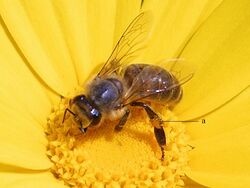Biology:Apoidea
| Apoidea | |
|---|---|

| |
| Apis mellifera, the western honeybee | |
| Scientific classification | |
| Domain: | Eukaryota |
| Kingdom: | Animalia |
| Phylum: | Arthropoda |
| Class: | Insecta |
| Order: | Hymenoptera |
| Suborder: | Apocrita |
| Superfamily: | Apoidea Latreille, 1802 |
| Subgroups | |
Incertae sedis
| |
The superfamily Apoidea is a major group within the Hymenoptera, which includes two traditionally recognized lineages, the "sphecoid" wasps, and the bees. Molecular phylogeny demonstrates that the bees arose from within the traditional "Crabronidae", so that grouping is paraphyletic, and this has led to a reclassification to produce monophyletic families.[1]
Nomenclature
Bees appear in recent classifications to be a specialized lineage of "crabronid" wasps that switched to the use of pollen and nectar as larval food, rather than insect prey; this makes the traditional "Crabronidae" a paraphyletic group. Accordingly, bees and sphecoids are now all grouped together in a single superfamily, and the older available name is "Apoidea" rather than "Sphecoidea" (which, like Spheciformes, has been used in the past, but also defined a paraphyletic group and has been abandoned).
As bees (not including their wasp ancestors) are still considered a monophyletic group, they are given a grouping between superfamily and family to unify all bees, Anthophila.[2]
Phylogeny
| |||||||||||||||||||||||||||||||||||||||||||||
This phylogenetic tree is based on Sann et al., 2018, which used phylogenomics to demonstrate that both the bees (Anthophila) and the Sphecidae arose from within the former "Crabronidae," which is therefore paraphyletic, and which they suggested should be split into several families; the former family Heterogynaidae nests within the Bembicidae, as defined by these authors.[1] These findings differ in several details from studies published by two other sets of authors in 2017, though all three studies demonstrate a paraphyletic "Crabronidae."[4][5]
| Apoidea |
| ||||||||||||||||||||||||||||||||||||||||||||||||||||||||||||||||||
References
- ↑ 1.0 1.1 Manuela Sann, Oliver Niehuis, Ralph S. Peters, Christoph Mayer, Alexey Kozlov, Lars Podsiadlowski, Sarah Bank, Karen Meusemann, Bernhard Misof, Christoph Bleidorn and Michael Ohl (2018) Phylogenomic analysis of Apoidea sheds new light on the sister group of bees. BMC Evolutionary Biology 18:71. doi:10.1186/s12862-018-1155-8
- ↑ Engel, M.S. (2005). Family-group names for bees (Hymenoptera: Apoidea). American Museum Novitates 3476: 1–33.
- ↑ Johnson, Brian R.; Borowiec, Marek L.; Chiu, Joanna C.; Lee, Ernest K.; Atallah, Joel; Ward, Philip S. (2013). "Phylogenomics resolves evolutionary relationships among ants, bees, and wasps". Current Biology 23 (20): 1–5. doi:10.1016/j.cub.2013.08.050. PMID 24094856.
- ↑ Branstetter, Michael G.; Danforth, Bryan N.; Pitts, James P.; Faircloth, Brant C.; Ward, Philip S.; Buffington, Matthew L.; Gates, Michael W.; Kula, Robert R. et al. (2017). "Phylogenomic Insights into the Evolution of Stinging Wasps and the Origins of Ants and Bees". Current Biology 27 (7): 1019–1025. doi:10.1016/j.cub.2017.03.027. PMID 28376325.
- ↑ Peters, Ralph S.; Krogmann, Lars; Mayer, Christoph; Donath, Alexander; Gunkel, Simon; Meusemann, Karen; Kozlov, Alexey; Podsiadlowski, Lars et al. (2017). "Evolutionary History of the Hymenoptera". Current Biology 27 (7): 1013–1018. doi:10.1016/j.cub.2017.01.027. PMID 28343967.
Further reading
- Grimaldi, D.; Engel, M.S. (2005). Evolution of the Insects. Cambridge University Press. ISBN 978-0-521-82149-0.
- Michener, C.D. (2000). The Bees of the World. Johns Hopkins University Press.
External links
- All Living Things Images, identification guides, and maps of Apoidea.
- Solitary Bees Popular introduction to the Hymenoptera Apoidea.
- Fiori e Api d'Albore and Intoppa Flower visiting bees in Europe pdf. In Italian but excellent table with Latin names.
- Native Bees of North America
Wikidata ☰ Q324132 entry
 |






